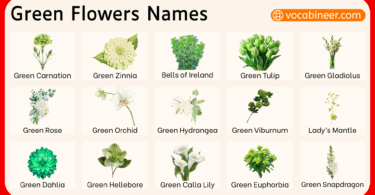Flower vegetables are the parts of a plant that grow from its flower or bud section and are used in cooking. These include items like broccoli, cauliflower, and banana flower, which come from the flowering part of the plant. In this post, you’ll learn the flower vegetables names in English with their pictures, grouped for easier memory and use. This helps learners build topic-based vocabulary with real food examples.
In This Page
What Are Flower Vegetables?
Flower vegetables are the edible parts of plants that come directly from their flower section. These include flower buds, blossoms, unopened flower heads, or sometimes the flower stalk. Unlike leafy or root vegetables, flower vegetables are harvested before or during the blooming stage. They are used in many traditional and modern dishes for their texture, flavor, and nutritional value.
Complete List of Flower Vegetables Names in English with Pictures
Flower vegetables are edible flowers or flower buds used in cooking. They offer unique flavors and textures and are rich in nutrients. Below is a complete list of flower vegetables names in English with pictures to help you recognize and learn about these special vegetables.
- Cauliflower
- Broccoli
- Artichoke
- Romanesco
- Capers
- Squash Blossoms
- Nasturtium Flowers
- Daylily Flowers
- Banana Flower
- Broccolini
- Kohlrabi Flowers
- Broccoli Rabe Flowers
- Chrysanthemum Leaves
- Globe Artichoke
- Saffron Crocus
- Broccoli Sprouts
- Cauliflower Leaves
- Chrysanthemum Flowers
- Cornflower
Common Flower Vegetables Names in English
These are familiar vegetables where the entire flower head is harvested before blooming. They’re part of everyday cooking and are rich in fiber and nutrients.
- Cauliflower: A white, dense flower head often used in cooking and salads.
- Broccoli: Green, tree-like clusters of flower buds rich in vitamins and fiber.
- Artichoke: Edible flower buds with tender leaves and a flavorful heart.
- Romanesco: A green vegetable with fractal-shaped flower heads, similar to cauliflower.
- Broccolini: A hybrid vegetable with long, slender stems and small broccoli-like florets.
- Capers: Small, pickled flower buds used as a seasoning or garnish.
- Squash Blossoms: The edible flowers of squash plants, often stuffed or fried.
Names of Edible Flower Buds and Blossoms
This group includes soft, tender flower buds or open blossoms that are eaten fresh or cooked. They add texture, color, and a mild flavor to dishes.
- Capers: Pickled flower buds with a tangy flavor, often used to garnish dishes and add zest to sauces.
- Squash Blossoms: Delicate flowers from squash plants, commonly stuffed with cheese or fried for a crispy treat.
- Broccoli Blossoms: Tender flower buds of broccoli, sometimes used fresh in salads or lightly cooked.
- Artichoke Buds: The unopened flower buds of the artichoke plant, steamed or boiled and eaten with dips.
- Nasturtium Flowers: Peppery-tasting flowers used fresh in salads or as a colorful garnish.
- Daylily Flowers: Mild-flavored blossoms eaten cooked or dried in various Asian cuisines.
- Banana Flowers: Large purple flower buds used in soups and salads in tropical cooking.
- Broccoli Rabe Flowers: Small, bitter flower buds used in Italian dishes, often sautéed with garlic.
- Chrysanthemum Flowers: Edible flowers used fresh or dried in teas and salads, with a slightly bitter taste.
- Pumpkin Blossoms: Flowers of the pumpkin plant, eaten stuffed, fried, or in soups.
Herb and Tree Flowers Used as Vegetables
These are flowers from herbal plants or trees used in savory or medicinal cooking. Some are used for garnishing, others are stir-fried or added to soups.
- Moringa Flowers: Small, edible white flowers used in soups and stir-fries.
- Sesbania Flowers: Purple or white flowers eaten cooked in Southeast Asian dishes.
- Banana Flowers: Large purple flower buds from banana trees used in salads and curries.
- Acacia Flowers: Used in some cuisines for their delicate flavor and texture.
- Hibiscus Flowers: Edible flowers used fresh in salads or dried for teas and cooking.
- Neem Flowers: Bitter flowers used in Indian cuisine for their unique taste and medicinal properties.
- Elderflower: Small white flowers used in syrups, beverages, and desserts.
- Jackfruit Flowers: Used in Southeast Asian cooking, often steamed or added to curries.

Regional Flower Vegetables in Asia and Africa
These are commonly used in local cuisines, especially in India, Southeast Asia, and some parts of Africa. They are rich in tradition and local names.
- Pumpkin Flower
- Sesbania Flower
- Moringa Flower
- Mahua Flower
- Sahana Flower
- Hibiscus Flower (edible type)
Full List of Flower Vegetables with Names and Examples
| Vegetable Name | Part Used | Usage Example |
|---|---|---|
| Broccoli | Flower head | Stir-fry, boiled, pasta, soups |
| Cauliflower | Flower head | Curries, steamed, baked, rice dishes |
| Artichoke | Flower bud | Grilled, stuffed, roasted |
| Banana Flower | Full flower | Curry, stir-fry, soups (South Asia) |
| Romanesco | Flower head | Steamed, roasted, sautéed |
| Capers | Pickled flower buds | Toppings, salad, pasta, sauces |
| Lotus Stem | Flower stalk | Stir-fry, curry, pickle, dry sabzi |
| Agathi Flower | Blossom | Stewed, boiled with lentils, curry |
| Chive Blossoms | Flower cluster | Salads, garnishing, egg dishes |
| Zucchini Flower | Blossom | Stuffed, fried, steamed |
| Pumpkin Flower | Flower blossom | Fried, dipped, added to rice |
| Sesbania Flower | Blossom | Light curry, stir-fry, fritters |
| Moringa Flower | Blossom | Lentil soup, green dishes |
| Mahua Flower | Dried flower | Tribal dishes, fermented foods |
| Sahana Flower | Blossom | Used in rural curries (India/Nepal) |
| Hibiscus Flower | Petals | Herbal dishes, sour stews, side dishes |
Nutritional and Culinary Benefits of Flower Vegetables
Flower vegetables are not just colorful and unique—they also provide important health benefits and add special textures and flavors to meals. They are often used in traditional dishes, side items, or herbal recipes, especially in Asian and Mediterranean cooking.
Nutritional Benefits
Flower vegetables are known for being:
- Rich in fiber – Helps with digestion and keeps the stomach healthy
- High in vitamins – Especially Vitamin C, Vitamin K, and some B-complex
- Low in calories – Good for light and healthy meals
- Full of antioxidants – Supports the immune system and reduces cell damage
- Source of minerals – Such as iron, calcium, and magnesium
Culinary Benefits
In cooking, flower vegetables offer:
- Variety in texture – From soft (banana flower) to firm (cauliflower)
- Mild to strong flavors – Some have a sweet or earthy taste, others are slightly bitter
- Multiple uses – Can be fried, boiled, steamed, stuffed, or pickled
- Easy to pair – Work well in curries, salads, soups, stews, and rice dishes
These vegetables are especially common in vegetarian, regional, and seasonal recipes. Some are also used for special diets or home remedies.
Flower Vegetables Used in Global Cuisines
| Region | Common Flower Vegetables |
|---|---|
| India | Banana Flower, Moringa Flower, Agathi, Pumpkin Flower |
| Southeast Asia | Banana Blossom, Lotus Stem, Sesbania Flower |
| Europe | Broccoli, Cauliflower, Artichoke, Capers |
| Africa | Hibiscus Flower, Mahua Flower, Pumpkin Blossom |
| Mediterranean | Capers, Artichokes, Chive Flowers |
Flower Vegetables vs Other Vegetable Types
| Category | Example | Part of Plant Used |
|---|---|---|
| Flower Vegetable | Cauliflower, Artichoke | Flower/bud |
| Leafy Vegetable | Spinach, Lettuce | Leaves |
| Root Vegetable | Carrot, Radish | Root |
| Stem Vegetable | Celery, Asparagus | Stalk |
| Fruit Vegetable | Tomato, Eggplant | Fruit body |
FAQs About Flower Vegetables Names in English
It’s a vegetable that comes from the flower part of a plant, such as broccoli or banana flower.
No. Only some flowers are safe and edible. Always cook or wash properly before eating.
Some can be eaten raw (like capers), but many are cooked for flavor and digestion.
Yes. Many such as banana flower, pumpkin flower, and moringa flowers are popular in Indian dishes.
Read More




